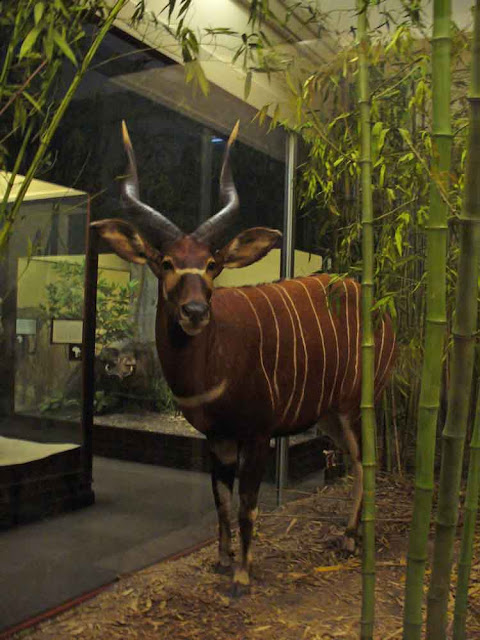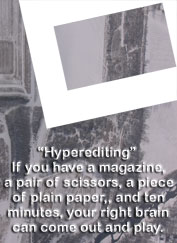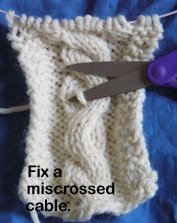I like to make sure to see the things I specifically want to see, in a museum. The biggest and most complete T. rex skeleton ever found, say.
I also like wandering around, finding things I had no idea were there, or even had no idea even existed......
We happened across an exhibit of things from Mesopotamia, that seemed sort of random and much less ... intensively-designed ... than most of the exhibits.
Can you read the words across the middle of this next image? "You're looking at .0002 percent of the Field Museum's total collections." That is a LOT of objects............ Imagining an "end of Raiders of the Lost Ark" sort of warehouse...........
Here's a closer look at the text in the white square at right, above.
Wow. A *lot* of objects, to catalog, preserve, store.......
We looked at some of the items from Mesopotamia.
Here is the "bronze stand with frog motif," encased in its sheltering plastic.
I didn't see the frog until I got the image into the computer and up on "the big screen." It's at the bottom, with an unfortunate amount of glare on the plastic......
At first I thought that part sticking forward, just under its head, was its lower jaw, but now I think it is its left front foot.
You can see the back of the box holding the frog, etc, in this next image, and the tall ceramic thing is the "pedestal for fruit" described in the image whose text begins "the past is fragile" above. These are really old human-made objects. Nearly 5000 years old. I read somewhere in this exhibit that Kish was a hotbed of design and technology.
So many of the objects that survive for thousands of years are the best of the best of the best. Precious when made, carefully preserved. I was interested to see these quickly-modeled small animals. They are a contrast to the meticulously decorated and refined sort of object one usually sees, from ancient times.
No one knows if these were toys, or what. I wonder what context they were found in, or if the context has been lost over time (looters!).
I believe the object I failed to capture, at right, above, was a cart. I read (after I got home!) that one of the things that was long believed to have been developed in Mesopotamia -- perhaps in Kish -- was the wheel. The little cart I believe is just out of the image above is one of the oldest known examples of a wheel on a vehicle. (Wish I had its picture! Next time..... If these things are still on view!)
Also found in Kish is what's left of a real cart wheel. As with the Viking "ghost ship," all that's left are the nails. But the shape of the wheel (though distorted over time) is clearly visible. This was pretty big. Over 2' in diameter, I think.
Unfortunately I did not notice the image of Henry Field and Dimna, let alone catch its likeness.
That info above says the past is fragile. I was thinking "the OBJECTS from the past are fragile," but then I thought -- our understanding of the past is also fragile. When we learn more, we often discover our previous conclusions or beliefs about the past are incorrect.
I read somewhere in this exhibit that, at the time the wheel above was found, it was believed wheels were invented in Mesopotamia. Now, apparently, it is believed that wheels were developed independently in multiple places.
Back to that "the past is fragile" thought -- the past (or at least the objects from the past) can also be dangerous!
I read info saying that it's not uncommon for artifacts to be contaminated with poisons. Sometimes deliberately -- taxidermy was often saturated with poisons, in an attempt to stop insect damage...... I've thought about archaeology being a dangerous job because of primitive sanitation and poor food-prep practice, but hadn't thought about it being dangerous because the objects themselves were dangerous!
If you scroll back up two pics, and look at the arsenically-dangerous bust, lying down, you may spot this next close crop from just above the bust's head-dress.
It's from that black and white wall of .0002 items, and, I bet it is our frog, from the bronze stand being attacked by active agents of destruction. I bet this is a looking-at-the-bottom-of-the-object view of that frog.
Walking on. There was a big exhibit on mammoths and mastodons in August of 2015. There were many apparently life-size models of various elephantine ancient beasts. I guess it was ok to touch them. I was very surprised that they were not only NOT protected, but there were no signs saying not to touch.................. I'm not sure.
The little girl's mother told her to hug this one.
Lucy wasn't the only creation in the museum that was painstaking crafted, hair by hair.......
It was getting late in the day, and our stamina was flagging. But you know we had to try out the mechanical trunks, manipulable via joysticks. The one in front curled sideways around that suspended weight, and then you could lift. The one in back curled from down to up around a horizontal weight.
It was easy to understand why learning how to use one's trunk takes a lot of time, and a lot of practice. Real trunks can curl every which way, in multiple directions at once. They are complicated!
This may be the biggest elephantine critter I've ever seen. This mastodon is tall!
I believe these teeth are (from left to right) a mammoth molar, a modern Asian elephant molar, and a mastodon molar. Mammoth molars are much more similar to modern-elephant molars than either are to mastodon molars. Mammoths and elephants ate grasses on grass-lands, and mastodons ate leaves and branches in forests, hence the need for different grinders.
Here's the descriptive info for the modern molar above. The University of Michigan has a nice display on mammoths vs mastodons. Kind of cool to see things from my local museum in a big "destination" sort of venue like the Field Museum!
I had to get my better half in to have a look at that amazing taxidermy section of the museum.
And that was it; the hour was getting on for closing time; we left.
The Field Museum is an amazing and wonderful place. If I lived in Chicago I would totally buy a pass, so I could go in whenever I wanted.
I have two suggestions for them. 1) Get escalators. And 2) -- rethink the way people get in. I waited a ridiculous more-than-15-minutes to get in, the first time, when there were about 15 people in line ahead of me, and four people working to sell tickets! It was about the same when we went back on the 14th. Part of the problem is that there are choices to make, and very little info about those choices before you get to the head of the line. They could put a lot more signage along the way through the line, so people have a better idea what they want *before* they get to the ticket agent!
My personal recommendation to visitors is -- buy the "full-feature ticket" which gets you into all of the "special" exhibits. When we were there, it was $31 vs $25 for the "regular ticket" -- for $25 you have to choose just one "special exhibit." I offer an additional recommendation to skip the "3-D movie." Such things, in my vast experience of two (2), are hokey and not worth the time to sit through them. Unfortunately, your ability to chose which stupid hokey 3-D movie you want complicates your ability to purchase advance tix online, as you have to pick your date in advance (so they can schedule you into your choice of movie).
This makes buying tix online ahead of time much less useful. So I guess I have three recommendations for the people who run the field museum, and the third is: let me decline the movie and buy an "any day between Aug 7 and Aug 20" otherwise full-feature ticket online, so I don't have to wait in line when I get there.
I will be back, and I want to spend my time with the incredible contents of the museum, rather than waiting in line to get in. Thank you.
There is an amazing view, from the steps in front of the Field Museum.
The sky was lovely, when we came outside.
This is just west of the museum. I didn't look for description........
My better half decided we had to eat some deep-dish pizza when we were in Chicago. He had done some wandering around, one day, and had picked up a menu for Giordano's.
We figured we could find something edible there, so we walked west, to Michigan Ave, and then south a few blocks to Giordano's.
We started with the house salad. It is described as "spring greens, romaine, arugula, heirloom tomatoes, radichio, and fresh fennel, tossed in a light lemon vinaigrette with shaved asiago blend." It was beautiful! It was delicious. I would eat it often, if I lived nearby! I don't think I'd ever eaten raw fennel. It was nice in this salad. Definitely recommended.
The pizza took a while, as it should if they make something like this just for you. Deep dish takes more than 15 seconds in a really hot oven........
This, too, was better than we were expecting, having picked a place because we knew it was there and we knew it served an iconic Chicago dish. We would eat this again, too.
As you can see, there is a LOT of it. We ate just over half of it, and took the rest back to the hotel, where it was kept safely on ice in our cooler.
If you spend a day at the south end of the museum complex, in the parks in central Chicago, consider heading just a bit farther south, and enjoy pizza and delicious salad at Giordano's.
There are tvs in Giordanos, but they are not so noisy that they drive you crazy. This is Zach Putnam, one of the Chicago White Sox pitchers, who was televised as as we ate salad and pizza.
You know I don't care about sports. But -- Zach was in our daughter's class in high school. Ann Arbor Pioneer, during our daughter's time there, was not your average high school. It had 17 AP classes, a National Champion women's swim team, a Grammy Gold winning music department, and I'm sure there were other honors I can't remember or never knew about.
Two of my daughter's swim teammates went to the Olympics -- Kara Lynn Joyce swam in the 50-yard freestyle in 2004, 2008, and 2012, winning silver medals on the 4x100 freestyle relay, and 4x100 medley relay teams in '04 and '08. Alison Gregorka was on the silver-medal-winning water polo team in 2008.
Zach Putnam played baseball in high school and college, and now pitches for the White Sox.
An incredible amount of talent, all in one place at one time, in the early 2000s!
Back in our hotel room, enjoying our spectacular view..................
.














































No comments:
Post a Comment